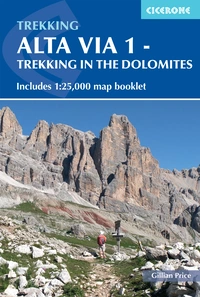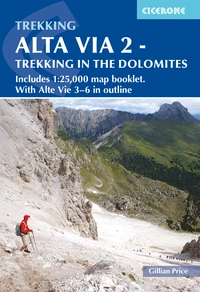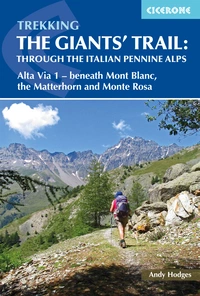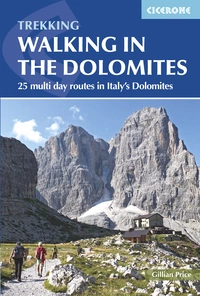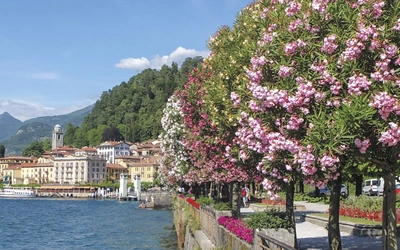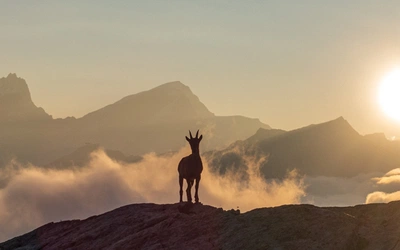What’s the Alta Via? Why are they numbered? Why are there two AV1 routes in Italy? I’m confused…
There are Alta Via trekking routes in two areas of the Italian Alps: the Dolomites and the Aosta Valley (Gran Paradiso/Mont Blanc). Read on to find out the difference between them.
What does Alta Via mean?
Well, to start with, Alta Via means ‘High Route’ or ‘High Way’ in Italian. The term is usually applied to long distance routes that take many days to complete and which go through high mountain terrain. Alta Via routes exist across the Italian Alps, but they can also be found in the Apennines mountains in the centre of the country. Some are regarded as Alta Via routes, yet don’t actually have the term ‘Alta Via’ in their names, such as the Tour of Mont Blanc and the epic Grande Traversata delle Alpi (GTA). Note, Alta Via is often abbreviated to ‘AV’.
What’s with the numbers?
A very special area of the eastern Italian Alps is called the Dolomites. Anyone who’s been to this mythical area to walk, climb, ski or do a via ferrata will speak about it in hushed tones, the vertical and overhanging limestone rock faces, the special culture of the region and the characterful rifugi being the standout memories for most visitors.
There are well over a dozen Alta Via routes in the Dolomites. Ten of these are known by a number rather than a name. Alta Via 1, 2, 3, 4, etc.
Dolomites and Aosta: the famous Alta Via routes
There are four principal Alta Via routes in Italy: the Dolomites Alta Via 1 and Alta Via 2, and the Aosta Valley Alta Via 1 and Alta Via 2. That’s not a typo and hence the confusion when someone asks about a guidebook to the Alta Via 1!
Dolomites
In the Dolomites, AV1 and AV2 (both linear routes) see the most visitors. AV1 (Alta Via 1) is 120km long with 11 stages. The walking does a lot of ascent and descent and passes through some beautiful areas, occasionally on exposed footpaths with easy cabled protection sections. It makes for a great first Alpine trek, but it is very popular, so you need to book the rifugi well ahead of time to be sure of a bed for each night.
AV2 is a different beast entirely. It’s probably one of the hardest treks in Europe, tackling long cable-protected (easier via Ferrata) sections, steep stone gullies, exposed traverses (sometimes without protection) and 12,500m of ascent over its 160km, two-week duration. You'll manage just fine if you’re comfortable on Grade 2 (UK) or Class 3 and 4 (USA) terrain. If you’re up to it, it is one of the best walks in the Alps.
Aosta
The Aosta valley is the long valley that stretches south from Mont Blanc, or Monte Bianco as the Italians call it. AV1 stretches in a line from east to west along the northern side of the great valley, under the shadows of Monte Rosa, the Matterhorn and Mont Blanc.
AV2 covers the south side of the valley, passing through the rugged Gran Paradiso National Park. The rewarding Alta Via 2 is a strenuous long-distance trek from Chardonney to Courmayeur passing beneath the foot of Mont Blanc, which will appeal to experienced Alpine trekkers. It is presented in 12 daily stages.
The two are commonly linked together to form the massive Tor de Geants (The Giant’s Trail): 31 days of trekking! Those who are into trail running might know that this is the route of one of the hardest ultramarathons in the world, where runners have a time limit of 150 hours (the best part of to complete the 330km and 24,000m ascent.
Whether you’re running or walking the Aosta Alta Via routes, you need to know that they are quite tough and high. Reaching an altitude of nearly 3,300m (that’s 700m higher than the highest point of the Tour de Mont Blanc!) and going through narrow passes, they require good mountain experience and fitness, but without the need to tackle cable protected sections.

